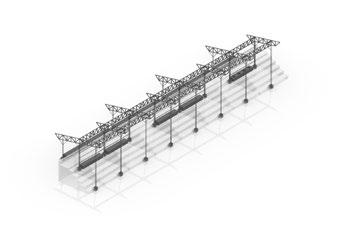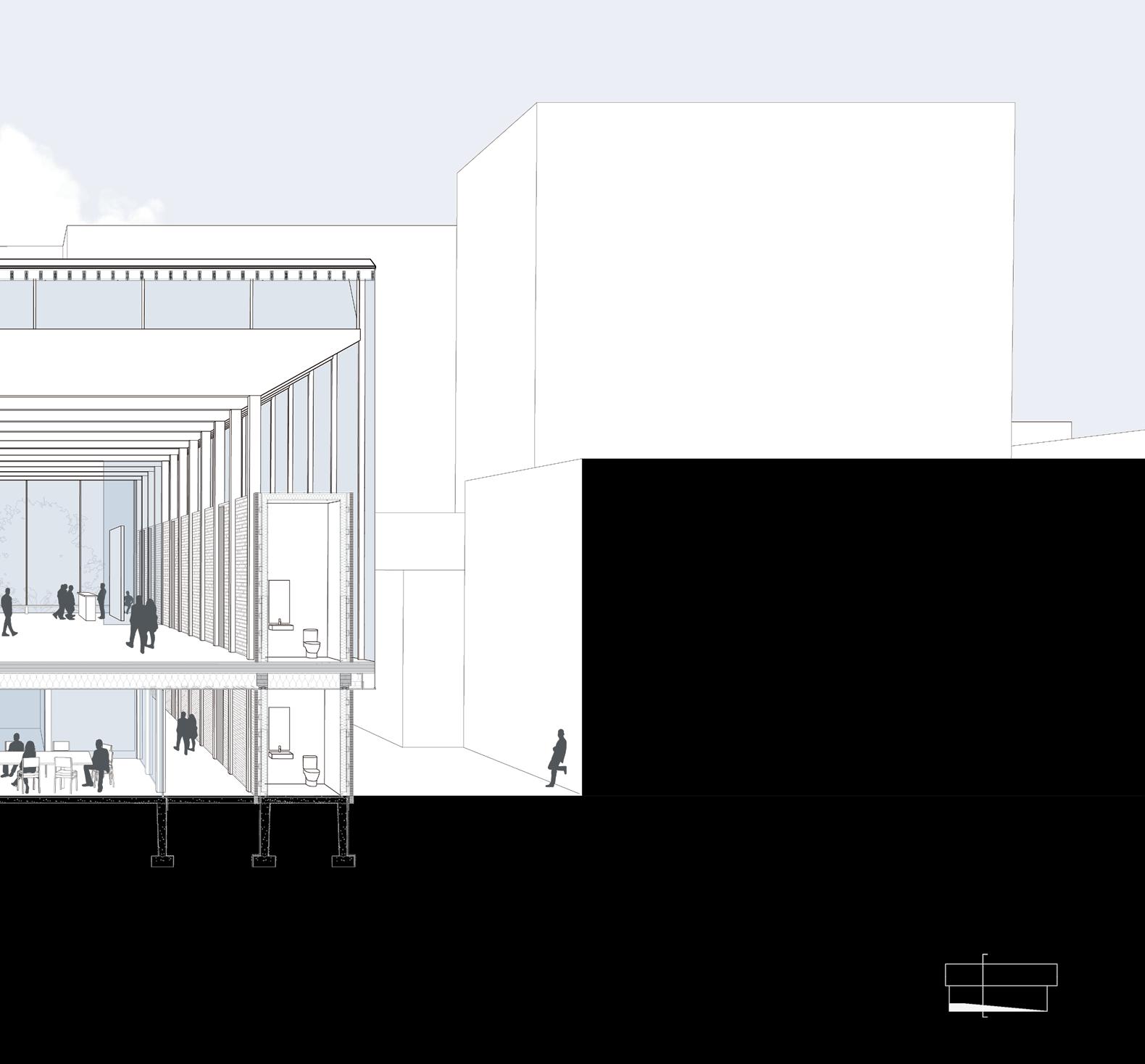

01 | Lio Lab
INFO
Place: Lima, Peru
Class: ARCH 403
Professor: Peter Zuroweste
Roles:
-Project Architect — focused on strategic integration of design ideas into the drawing set from Concept Design to Construction Documentation -Construction Fabrication Specialist — focused on cedar footing lathing, cedar to bamboo connections, column and beam fabrication, and the erection / assembly

RDG-Bussard Scholarship Competition Finalist
Substance Competition Finalist
ABSTRACT
Lio Lab is a collaboration between Iowa State University and Universidad Privada del Norte. Through forging connections within local communities, the collaborative nature of Lio Lab exists with the goal of creating urban landscapes of care through methods of tactical urbanism, and designing for understanding of people and their specific place. This semester, Lio Lab designed and built a shading structure for Fundación Fé y Alegría N°34; a K-12 school located in the district of Chorillios in Lima, Peru. Fé y Alegria N°34, and the community surrounding, has communicated the need to improve the shading structures along their recreational fields. These shading structures are important to the local community in order to protect parents and their children from the searing equatorial sun as they play. This project aims to enhance the urban environment for the community of Chorrillos through tactical design and community support.
The shading structure for Fé y Alegría N°34 was, through great discourse, rigorously designed for constructability and the specific site. Over the course of 18 days, the structure was built by the hands of students from both Iowa State University and Universidad Privada del Norte. It is made of carefully selected materials, with the main components consisting of bamboo, metal, CMUs, jute fabric, and cedar components. This is a blend of materials found in the Northern and Southern Hemispheres, making this project a blend of cultures and universities coming together.















































































02 | Mass Timber Manhattanism
INFO
Place: New York City, New York
Class: ARCH 302
Professor: Peter Zuroweste
Collaborators: Makenna
McManemy, Morgan Schofield

ABSTRACT
Cities aim to create hyper-density, and Manhattan is no different with ideas of vertical expansion at the forefront to achieve this goal. In order to support this congestion, the city requires architecture that not only houses people, but will positively contribute to the population’s overall well-being.
Being located in the heart of the Chinatown district, Mass Timber Manhattanism lends itself to the surrounding population by hosting an authentic Chinese spice market. This spice market itself is supported by elevated greenspace which hosts the herbs sold below. This in combination with the surrounding local market allows residents to buy their groceries while ensuring fresh ingredients.
The apartments above the market support a variety of clients and each floor can support multigenerational living, which is often seen within Chinese culture. To elevate each space, every apartment has a balcony to provide the residents with private outdoor space while there is also a semi-private rooftop terrace available as a common area for residents.
Due to the large amount of glass, a vertical louver system aids in reducing solar heat gain while providing the complex with a unique facade.



First Floor Plan
The first floor accommodates the Chinese spice market. All spices are encased in tubes with releases at the bottom. This floor also acts as the starting point of a circular greenspace that climbs the entirety of the building.


Second Floor Plan
The second floor has a lookout spot over the main area of the spice shop and some of the gardens. There are indoor and outdoor gardening areas to support the needs of the plant life.

These three floors are all apartment levels that host the circular greenspace on the south side of the building. There is a three bedroom unit as well as two single bedroom units on each floor.
These two floors include a three bedroom unit and two single bedroom units. One of the single bedroom units is fully accessible but all have access to the circular greenspace to the south.



During the creation stage of this model, the task of representing a curved facade was a challenge. By cutting the wood such that the grain was vertical, we were then able to boil it in water, then bend it to its desired shape. 3D printed molds were used to create the correct curvature while binder clips held the damp wood to the molds until dry.

Each floor plate was laser cut and the walls were engraved to ensure a perfect alignment. By assembling each floor separately, the model was easily able to stack and showcase the process of Manhattanism.



03 | Des Moines Civic Center
INFO
Place: Des Moines, Iowa
Class: ARCH 401
Professor: Andrew Gleeson
Collaborator: Ella Kannegiesser

ABSTRACT
Democracy is an affair meant to be for the people and by the people, but typical federal buildings do not reflect this principle. Neoclassicism is based on an outdated architectural form which attempts to showcase the power of the government rather than give the power to the people.
The predominately glass facade conveys both literal and metaphorical transparency; which provides the voters a more open and accessible environment to government participation. This transparent facade does come with heating issues, which are resolved in a multitude of ways including: vertical louvers, a double-skinner window system, and fritting.
Solar panels will enable energy production on site and in conjunction with the mass timber structural system utilize renewable resources and contribute to the sustainability movement.
This architectural system includes multiple stages for the public. The sloped plaza creates a theater for free speech while the drop at the back creates a platform for lectures. The primary caucus space showcases a long span structural system, leaving the area open for politics and the people.





Lobby
Caucus Space
Storage
Office
Break Room
Locker Room
Voter History Museum
Recieving
Conference Room 0- Back of House Spaces








04 | Elysium INFO
Place: Rome, Italy
Class: ARCH 402
Professors: Consuelo Nuñez Ciuffa, Lavinia Minciacchi, Matilde Mellini
Collaborators: Allison Lassiter, Jessy Muo

ABSTRACT
Elysium reimagines San Lorenzo’s urban fabric by introducing three distinct open spaces that respond to the city’s limited communal green areas. By integrating these spaces with the site’s natural topography, the project creates a seamless dialogue between built form and landscape.
The design process carefully navigates the site’s elevation changes, utilizing an artificial drop to define two distinct areas. A bending volume frames the site while creating intimate garden spaces, reinforcing connections between residents and nature. Circulation strategies prioritize accessibility and engagement with the historic Aurelian Wall, transforming a former roadway into a vibrant public green space.
The program is organized to foster community interaction, with public functions at ground level and residential spaces above. A mix of dormitory-style and family units promotes diverse living experiences, linked by shared spaces and external circulation. Through strategic spatial manipulations, Elysium enhances urban life, celebrating the intersection of history, community, and contemporary design.












05 | Soul City Lofts
INFO
Place: New York City, New York
Class: ARCH 348 + ARCH348L
Professor: Bosuk Hur
Collaborators: Drew Supina, Hannah Banaszak

Wells Competition Finalist
ABSTRACT
Having a structural material assigned can relieve headaches, but can also create challenges. Each material has its own advantages and weaknesses. Precast concrete can allow for quick assembly, but the pieces must be kept small enough to be shipped to the site.
Urban infill sites are often hard to work with due to the slim nature which creates a very long, thin building.
Apartments in New York City are often and have limited access to the outdoors. To combat this, each of these apartments have private outdoor space, leaving the middle of the building for vertical circulation. There is also access to a backyard for the residents to have a semi private outdoor space.
The modular design allows for easier and cheaper construction. The precast system allows this apartment system to be built on any site, expanding or limiting the amount of units placed.






06 | New York City Housing Authority Analysis
INFO
Place: New York City, New York
Class: ARCH 302
Professor: Peter Zuroweste
Collaborators: None

ABSTRACT
NYCHA housing projects, built primarily in the mid 20th century, followed the tower in the park model, influenced by modernist ideals of open space, daylight, and air circulation. These developments prioritized high-rise buildings on superblocks, separating residents from the traditional street grid. While this design aimed to improve living conditions by maximizing access to sunlight and ventilation, it often resulted in underutilized green spaces and a lack of street-level engagement, contributing to feelings of isolation.
The Baruch Houses, completed in 1959, exemplify this approach. With 17 towers arranged across a superblock, the project provides ample access to daylight through large windows and building orientation. However, the expansive open spaces lack clear programming, creating disconnected pockets rather than active public areas. Additionally, the break from the city grid reduces pedestrian accessibility. While Baruch Houses successfully integrates natural light and air, it also highlights the challenges of large-scale public housing in fostering vibrant, connected communities.


Cell: 224-250-6265 | Email: jacobbainbridge150@gmail.com
